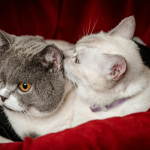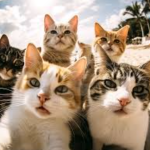Cats kneading, often described as “making biscuits,” is a common feline behavior rooted in instinct. This action involves repetitive paw pressing into a soft surface, resembling dough kneading. But why do cats exhibit this behavior, and what does it signify? Here’s a look at the reasons behind cats’ kneading actions and ways to manage this behavior:
Why Cats Knead Their Paws:
Early Beginnings:
- Kitten Nursing: It typically starts during kittenhood while nursing, stimulating milk flow from their mother. This behavior induces comfort and contentment associated with being around the mother.
Territorial Marking and Comfort:
- Scent Marking: Cats have scent glands in their paws, depositing their unique scent while kneading to mark their territory.
- Relaxation and Stress Relief: Kneading also serves as a relaxation method, offering stress relief akin to nursing, and aids in muscle stretching and tension release.
Behavioral Expression:
- Wild Instincts: Wild felines also knead soft surfaces in their habitats as part of their pre-rest ritual.
Kneading on Different Surfaces:
- Blankets and Objects: Cats knead blankets or soft surfaces to create a sense of calmness, prepare their sleeping areas, and mark their ownership through scent.
Kneading You:
- Sign of Affection: Kneading on you may signify affection and comfort, akin to their behavior with their mother during kittenhood.
- Territorial Marking: Additionally, kneading on you may serve as a way for your cat to mark you with its scent, claiming you as its own.
When to Pay Attention:
- Excessive Kneading: Increased or excessive kneading might signal discomfort, anxiety, or compulsive behavior, potentially indicating an underlying medical issue.
Managing Kneading Behavior:
- Talk to Your Vet: Seek advice from your vet to address underlying stress or medical conditions. Consider stress-reducing aids like pheromone diffusers or supplements.
- Avoid Punishment: Do not punish your cat for kneading; it may induce fear and won’t deter the behavior.
- Offer Alternatives: Direct kneading to designated areas, like a blanket, and consistently praise and reward your cat when they use these spots.
- Avoid Declawing: Declawing is painful and should never be a solution to kneading issues. Instead, trim your cat’s claws regularly to minimize discomfort.
Understanding why cats knead and acknowledging its significance allows pet owners to manage this natural behavior positively, ensuring a comfortable and stress-free environment for their furry companions.




